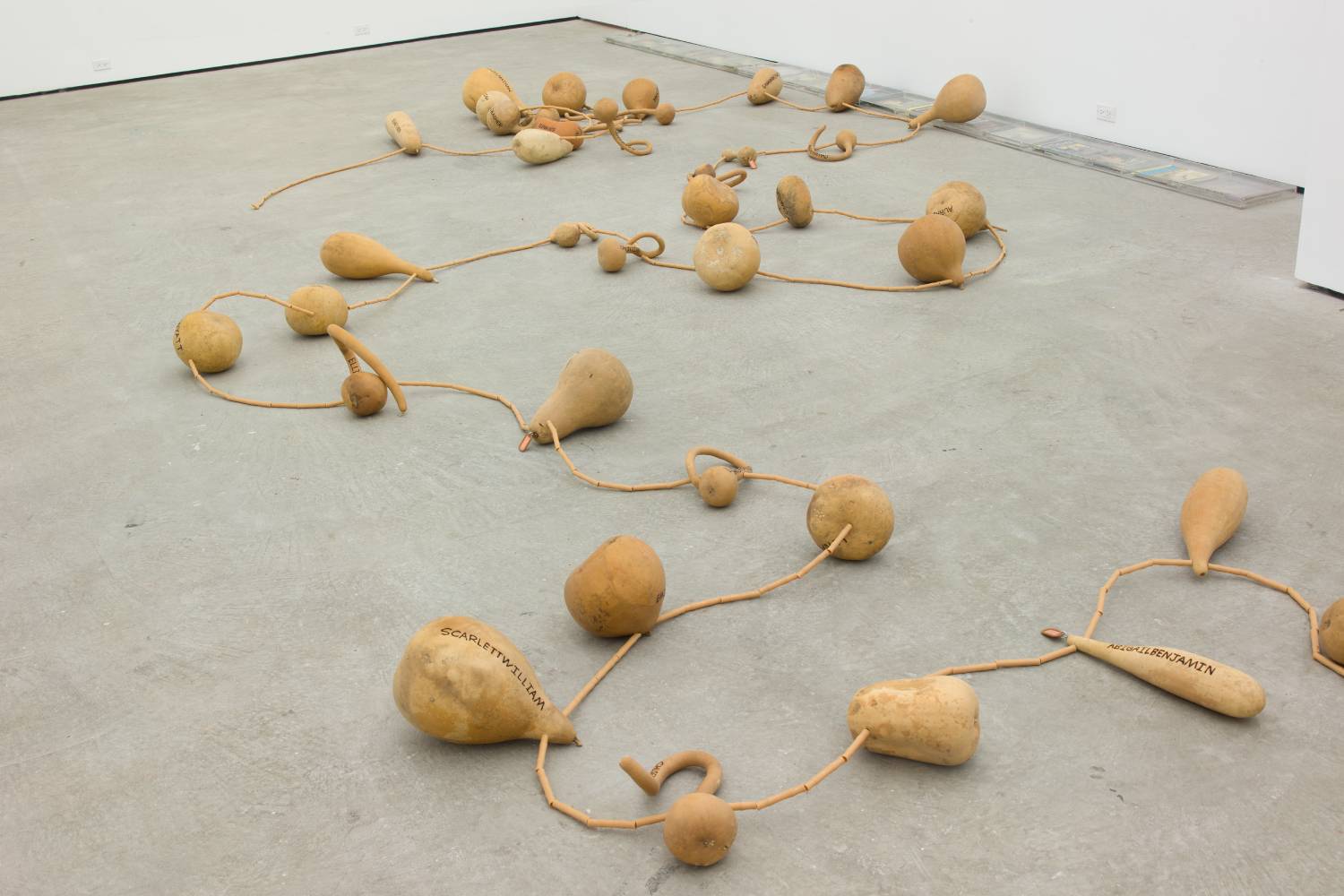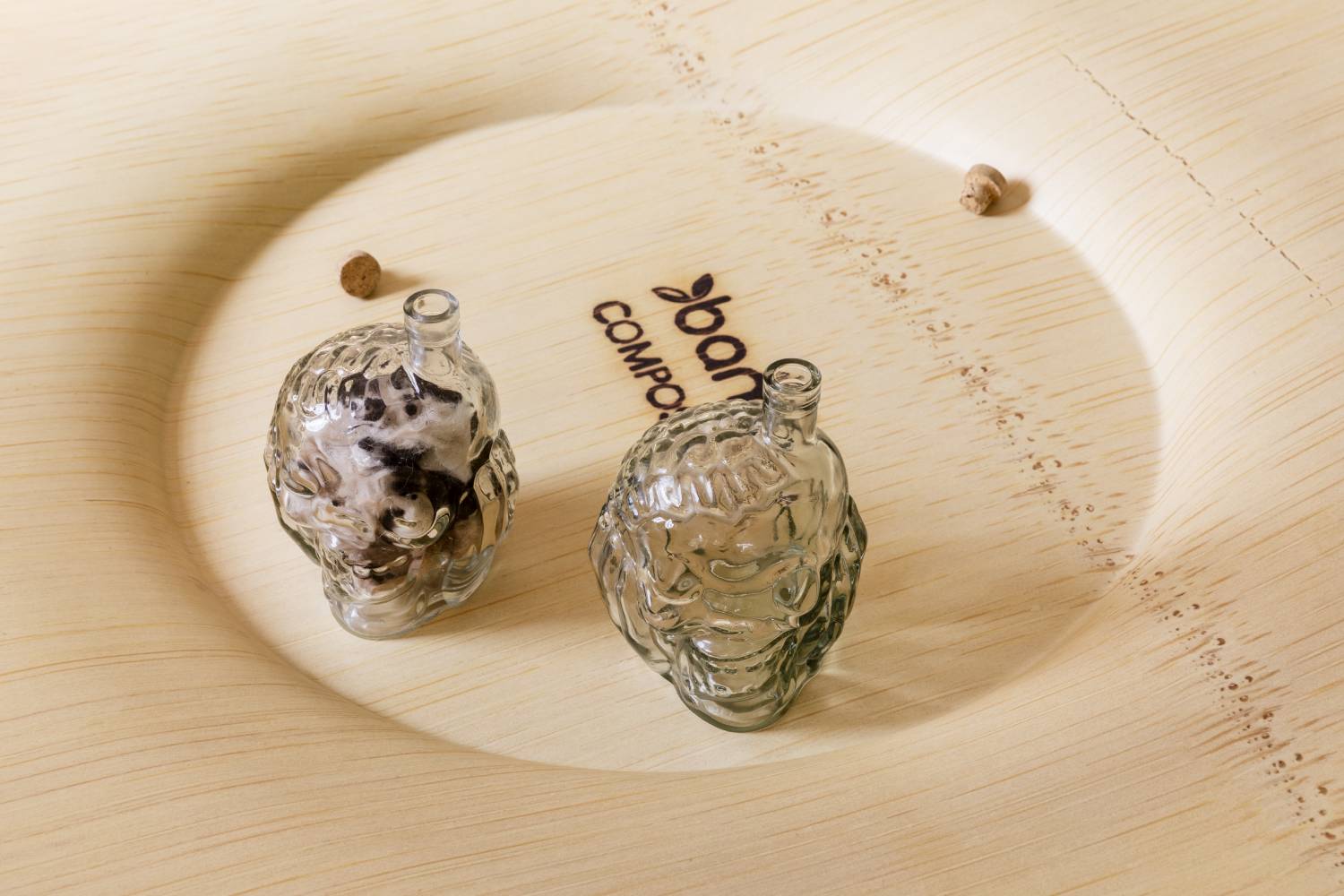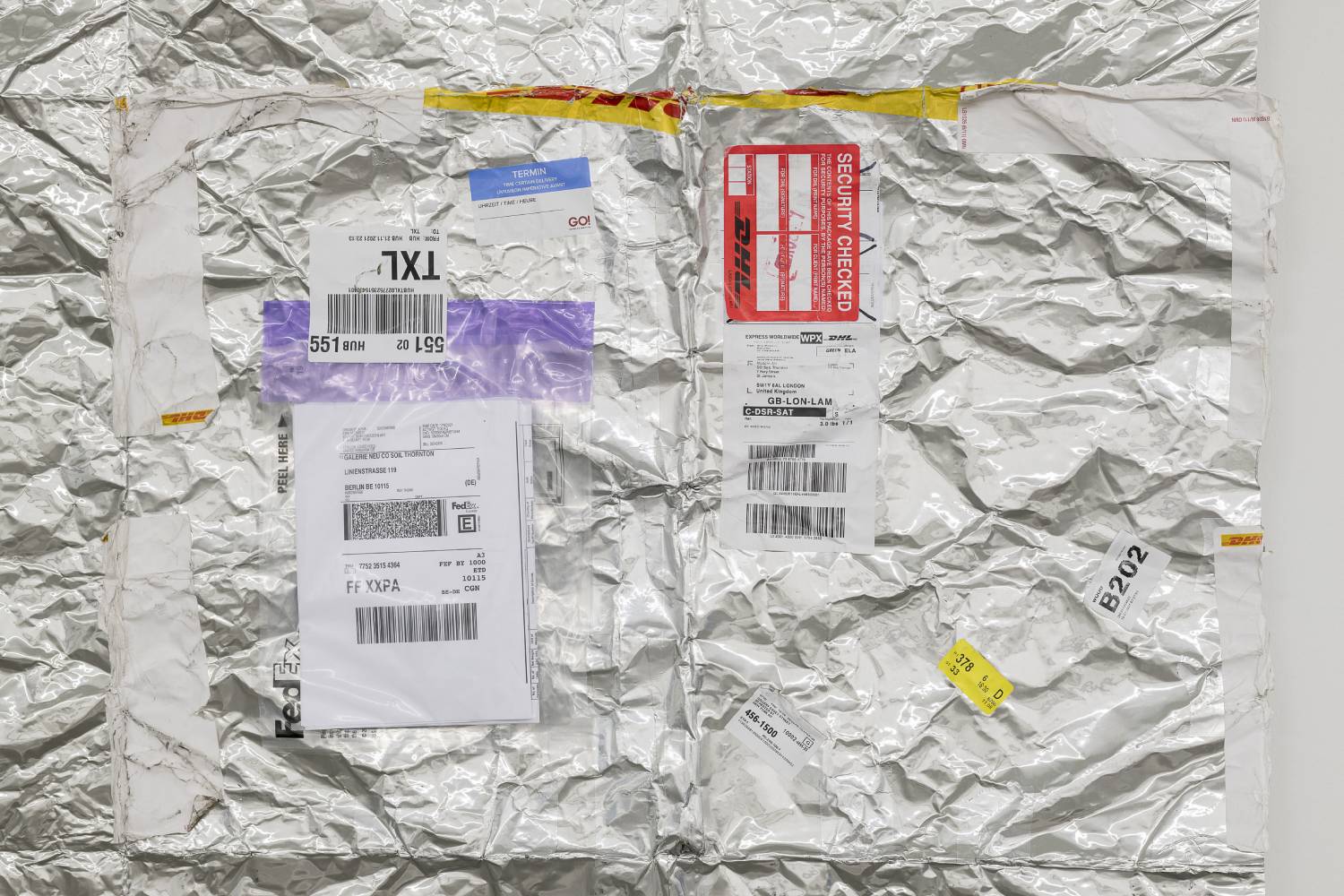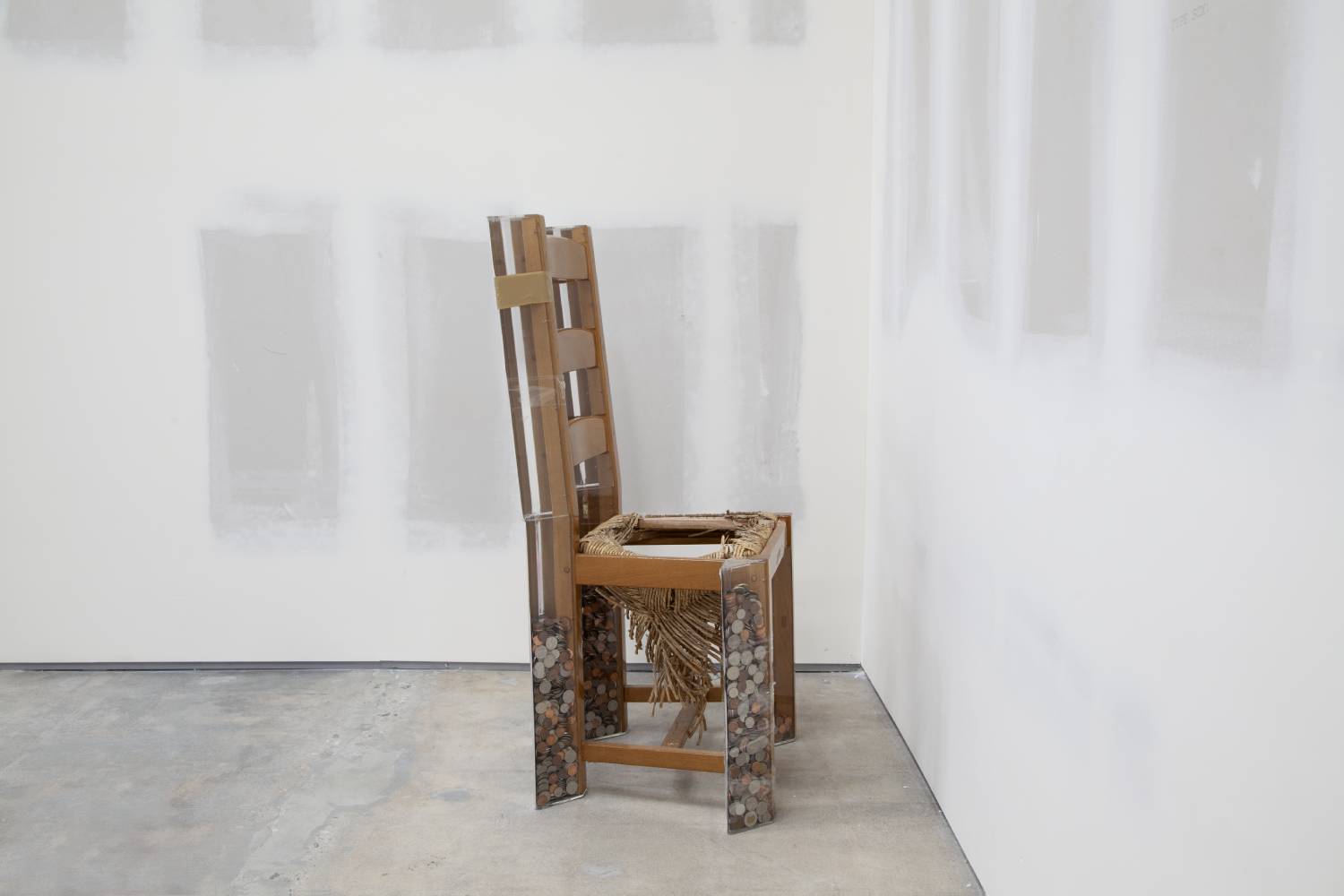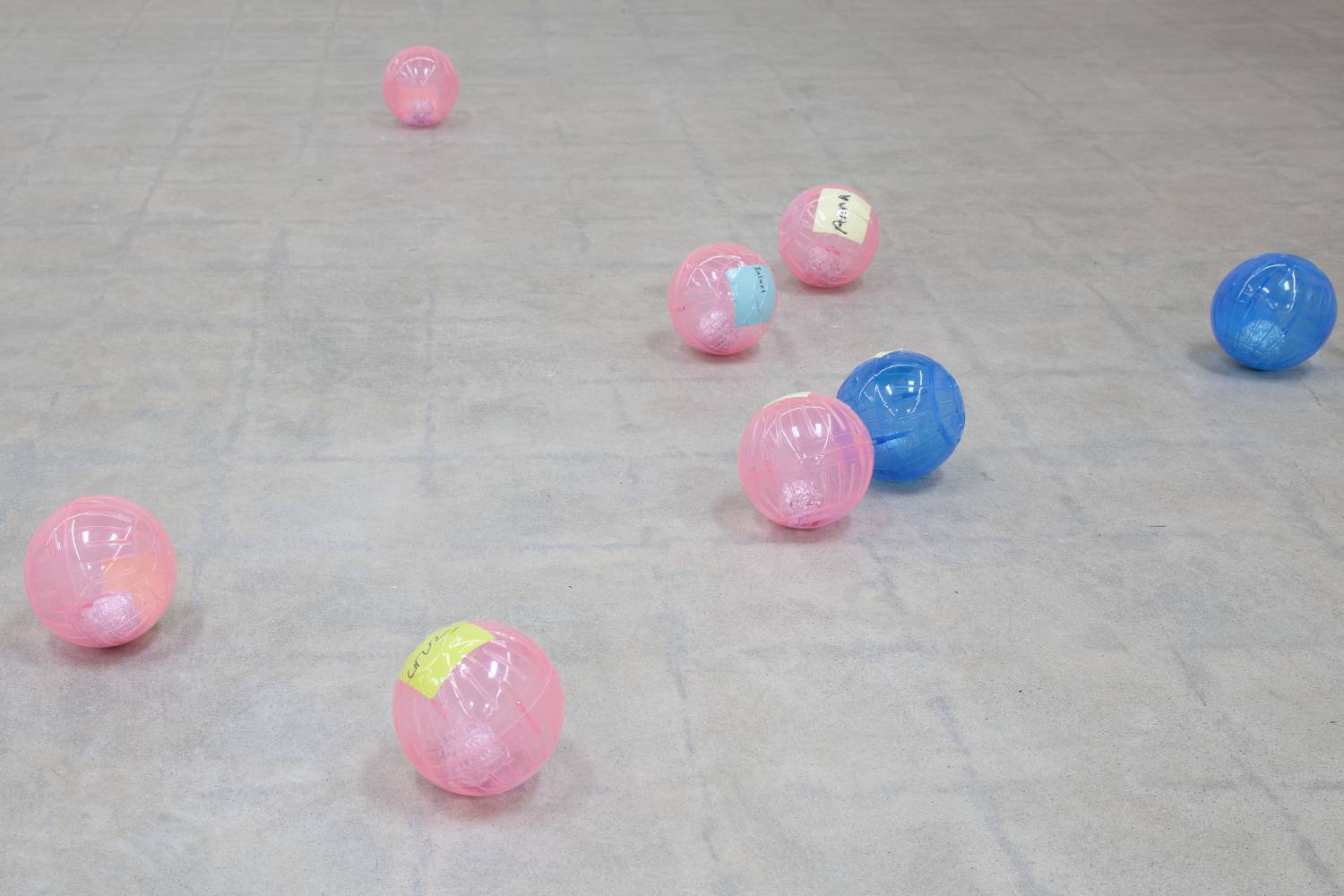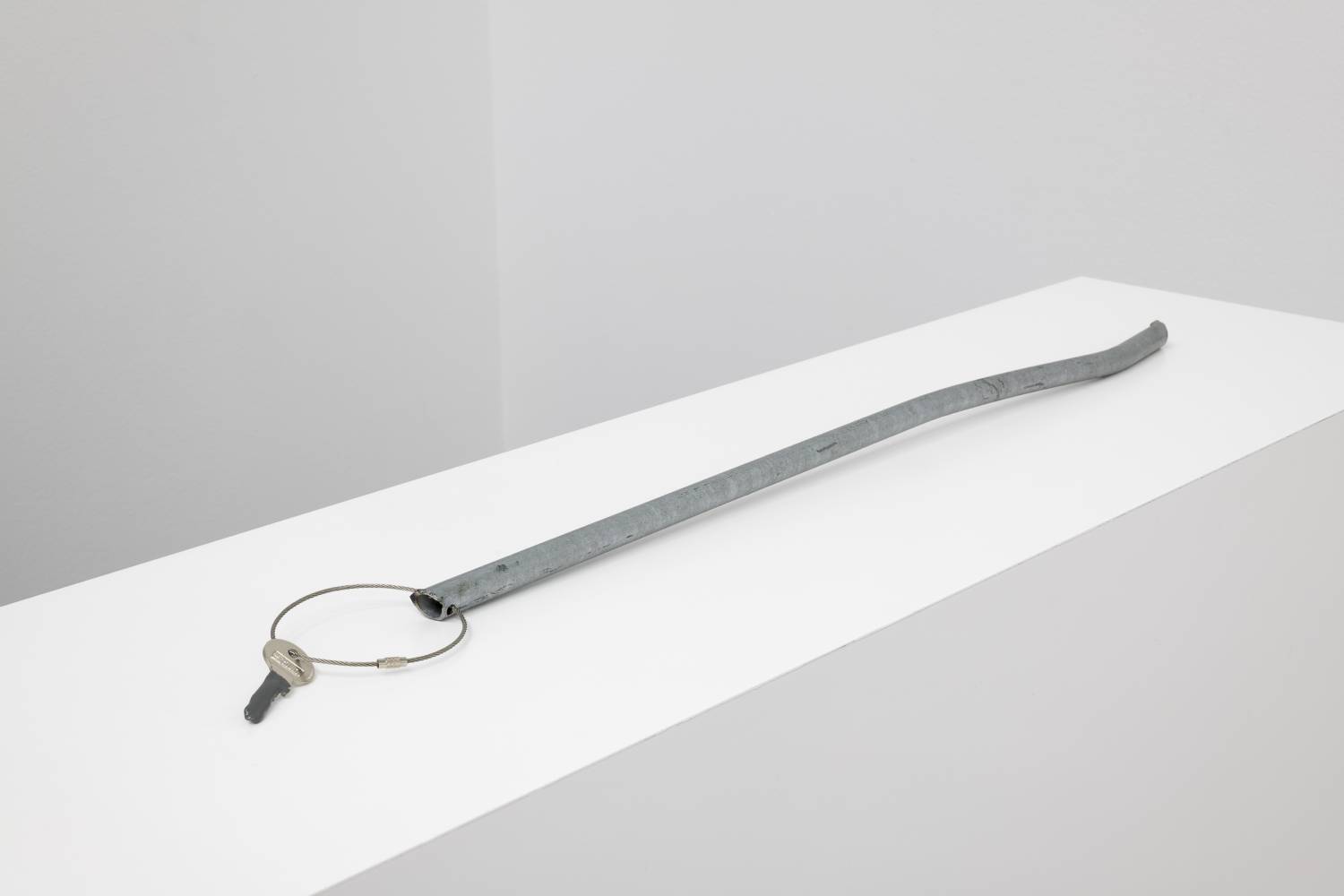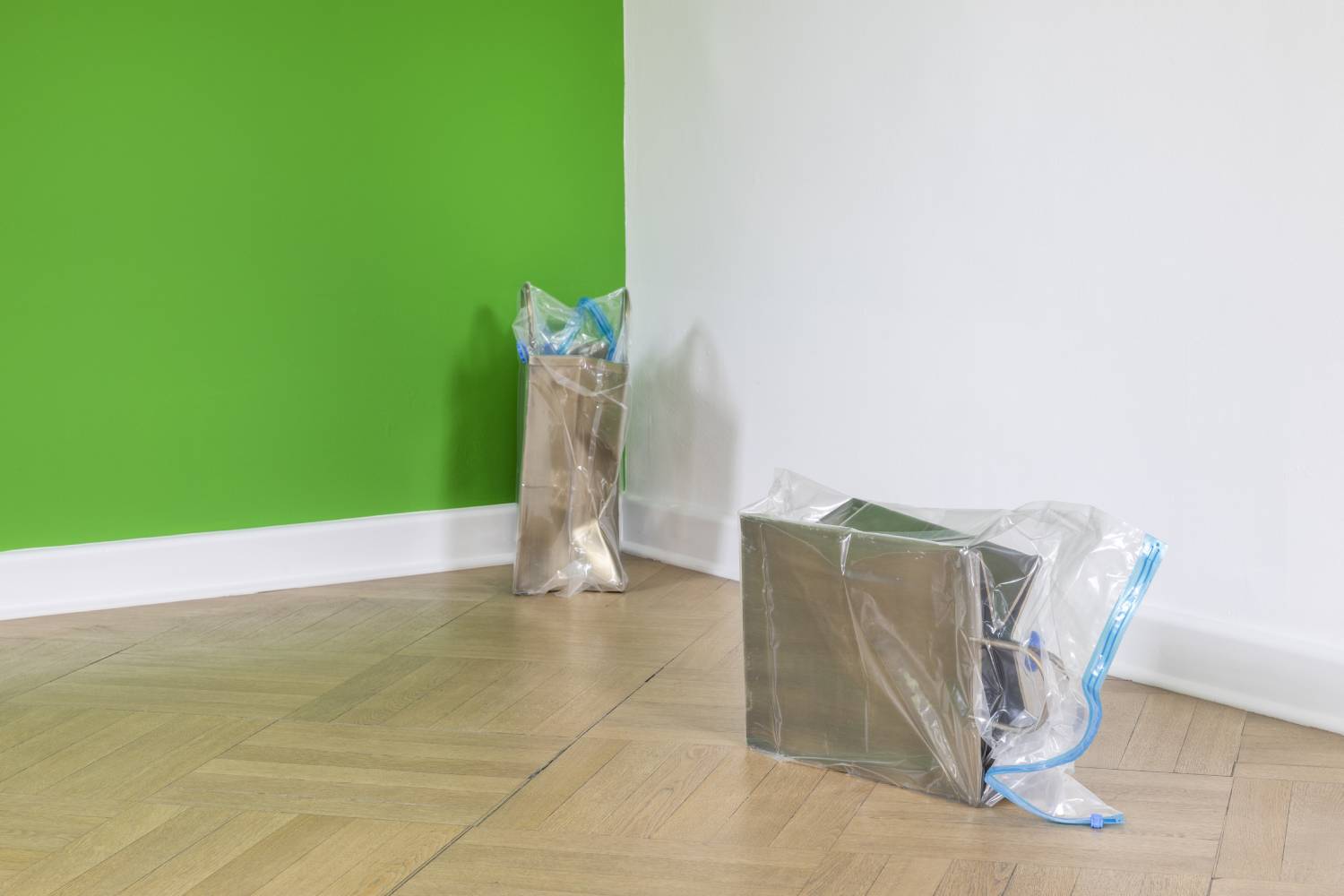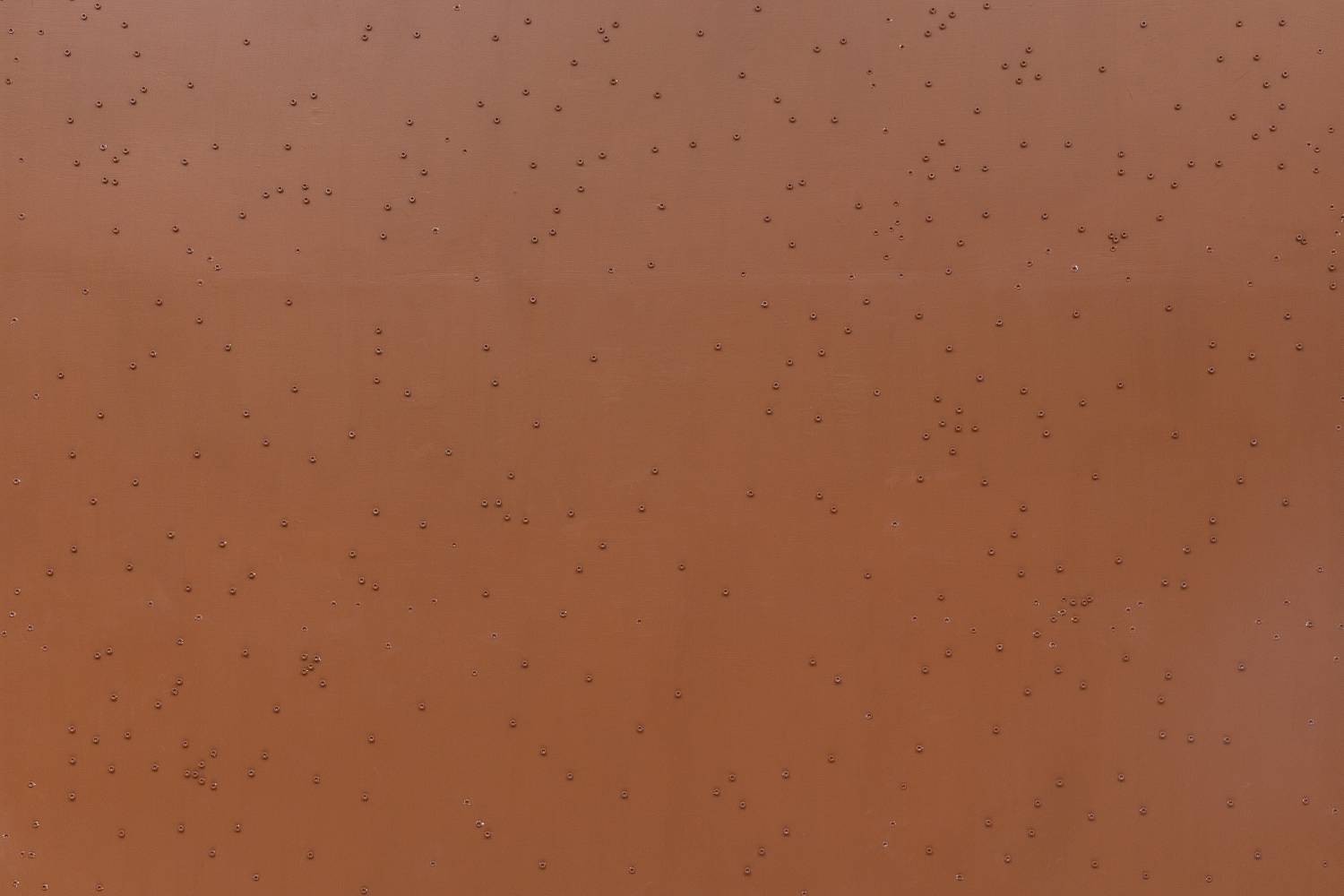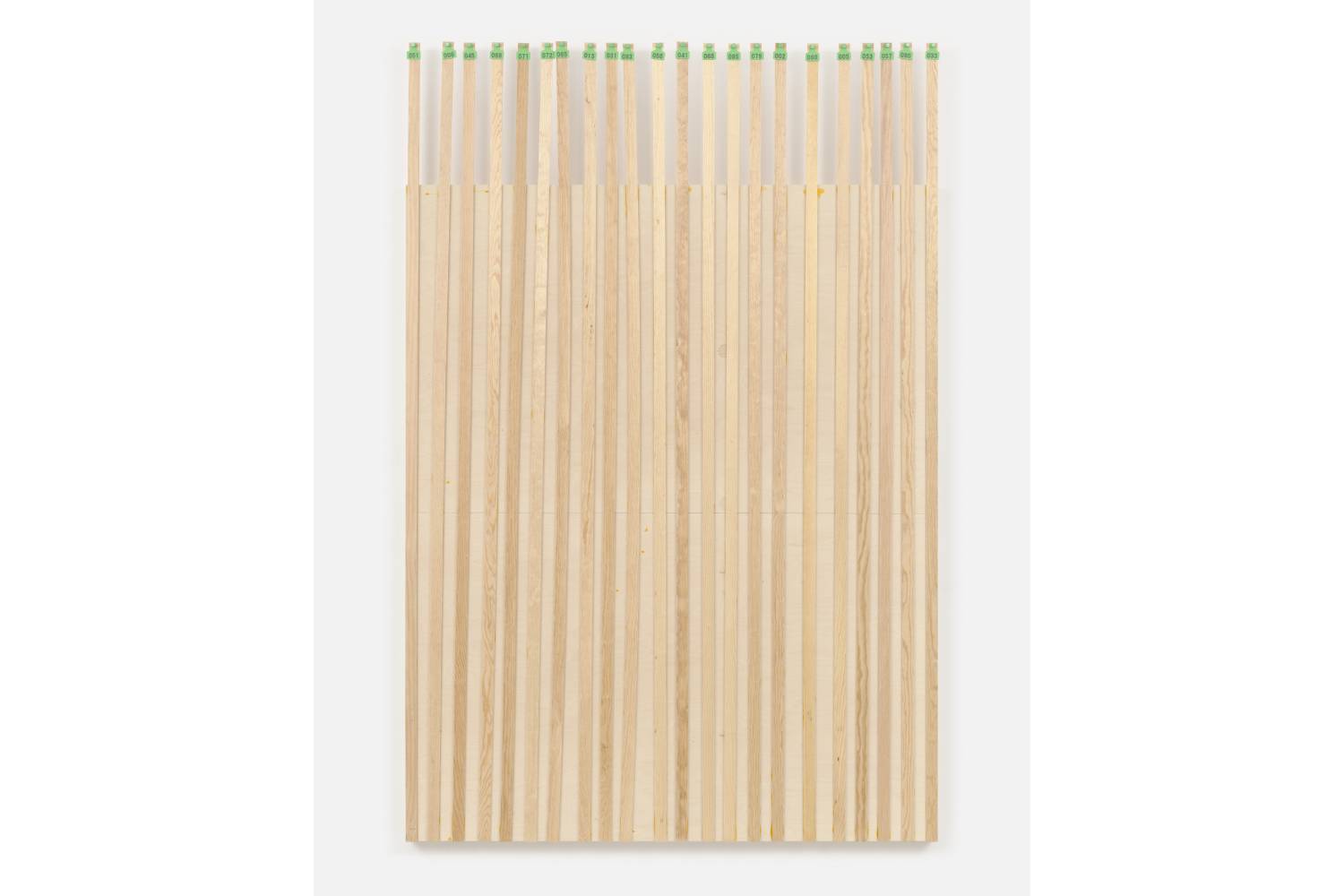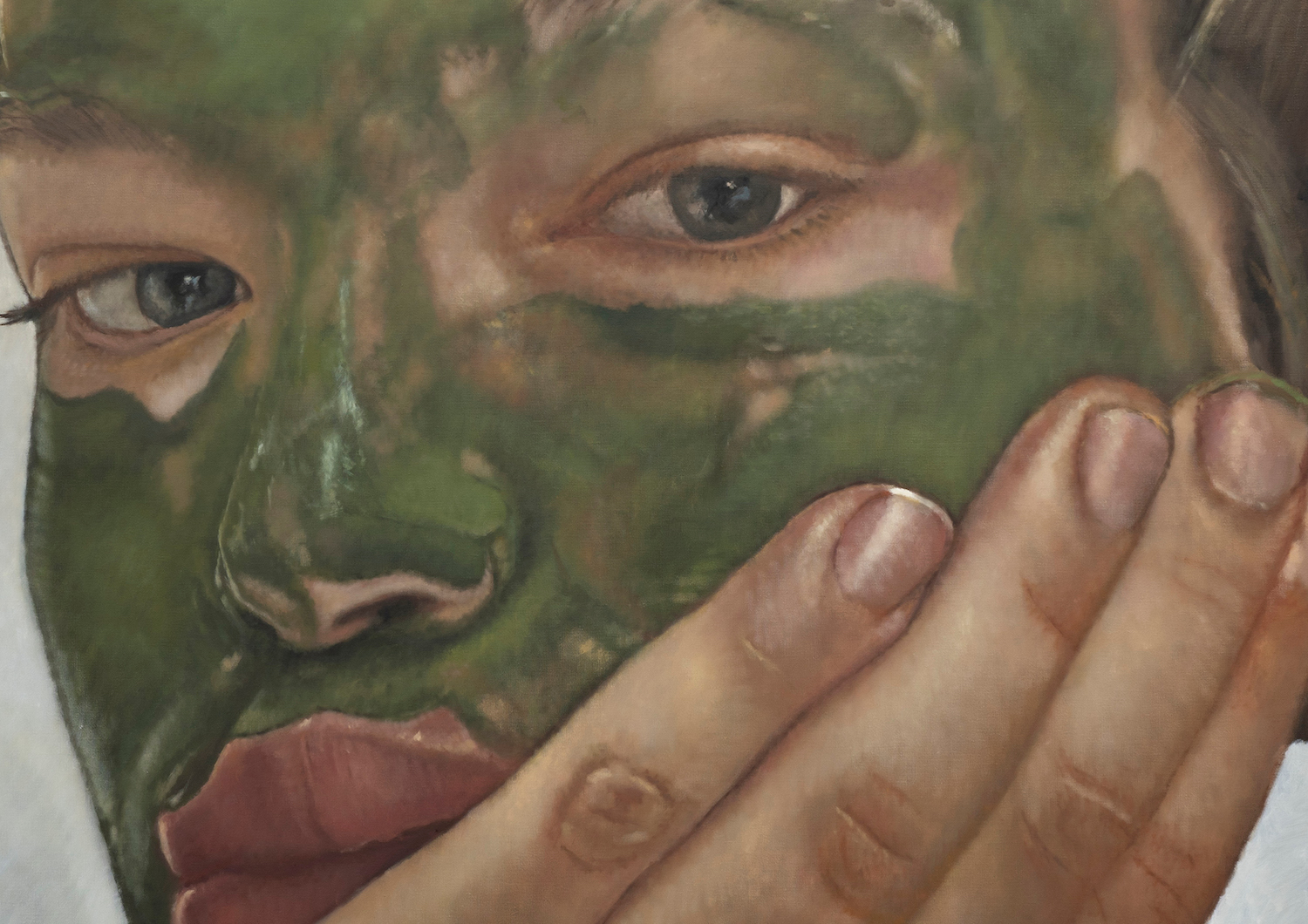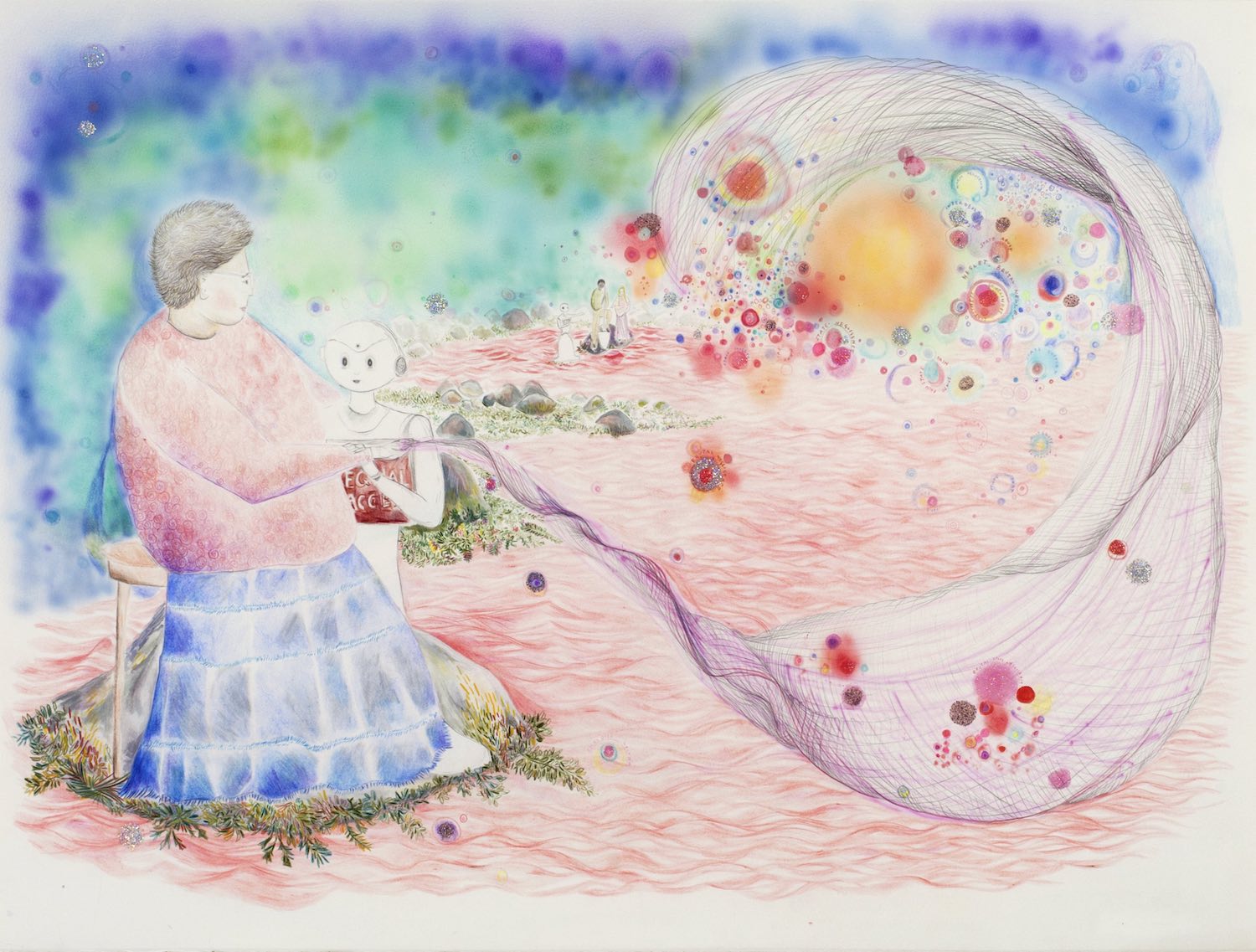Again: does productivity know what it’s named, maybe it calls itself identity?1 That spinning coin, productivity and identity, ever flickering. On waking, waiting for the chlorinated cerulean of the sky to dilute into a workaday shade of gray. The sky is an envelope, a boner, a protein. Tuesday was gumdroppink bathos. Sunday was lilac-buttplug laxity. To choose what to see is a rare affordance. Look around. Perception now always less clarified certitude than calculated distortion. Detection. If I’m in my cynicism, contemporaneity gloats, the only certitude is distortion. Calibrated appearances are the shifty skins of holographic capital, dumb positivism, and performative emancipation churning in its machinations. Oh, sad passions everywhere!
SoiL Thornton has long addressed perception’s temperatures and temperaments and their affects upon identity, knowing the possible transcendence offered in the fictive and faux. Slice of Stabilo Boss fluorescent green inside New York hunter green2. Clownfish acclimatizing to the anemone’s dizzying sting 3. Here, I get flirtatious discontinuities like a compass out of whack. Here, I get sensitive to the limitations of my vision. Difficult pleasures and ambiguities of pain, of belonging. Ultraviolet on pink. The cagey dilemmas of these works result from the imbricated tensions of self-determination and the interpretative violence of capitalist recuperation, signaling the fragile, fevered dynamics of ownership and value. Mindful of artistic subjectivity, Thornton reflects on the infrastructural constitution of identity, foremost of the artist as capital and commodity, to assail modalities of legibility as such.
Openly, Thornton writes: “It’s useful at times to use yourself as a guinea pig to explore or analyze societal precarity, oppressive infrastructures or even complex pleasures, but how easy is it to begin to talk yourself into perpetuating ideas of narcissism and vanity play, slippages abundant? The fine line.”4 “You can be your own voyeur.” 5 Leveled at the fetishization of identity, or “Bio this bio that, biography as trap,” Thornton delves into a Glissantian right to opacity often through protean “abstraction” collaged by everyday impressions. This heterogenic creation considers how meaning comes to be and for whom or in what ways such meaning sticks or becomes a vehicle. The tension between an idea and its material execution extends at times to contextual imbrications, with settings treated as features of difference — opened out from properties of codification through the relation of exposure and obstruction 6.
Opalescent rifts between idea and material are furled in the mind, reflecting close, or else incorporated, conditions of selfhood and experience. Thornton’s careful attention to formal qualities of sourced material is readily pronounced in their expanded sense of painting, and their corruption of it as a category. Painted stones adorn a giant steel saw blade like flares to Bataille’s circular “solar anus” (Painting, 2017), while syrupy daubs of brown color samples and centered paint palettes appear as metaphors for color tests. Large padded plus signs of plushy mattresses make painting beddable with ordinary intimacies; iterations adorned with elongated pennies or smothered black-gold with a blushing mesh of dog tags. A baby grand piano lid lacquered in black, non-drying, anti-climb paint — an asymmetric heart, its living expression ever wet (Whose Authorship In Living Denied Expression, 2019). A hole cut in splattered cardboard, a glory hole worded whole glory — something sickly inconceivable, a hollow whole (Whole Glory, 2014–19). A constellation of star-headed screws driven into a rusted expanse, each perforation splintering a galaxy of irregular rings (Who’s dirt above the rest (Honeoye (HUNe-oy) as one amongst other New York soils) (pre name change), 2020).
This formal rush, wracked and riven by the rash of description, does indeed have a high “re-watch value.”7 This is partly due to Thornton’s ventilation of definition. Meaning is oxygenated in their language, across titles and lists of media; their semantics are heady with vast digressions of interiority and location, with patchy syntactical fixture offered in anecdote, transaction, sensation, evidence. Citing entanglements of cultural and linguistic hegemony, their work thrives in the raw and indeterminate, the elliptical and deconstructive. In the throes of exchange, the works are drifty and discrepant, faintly guarded excitations, discursively overflowing. Theirs is a handwriting of mutability.
Thornton’s grammar of deconstruction negotiates the preconditions of social value and accessibility across space and discourse. To ask “who makes who at home,” for instance, is to needle a dynamic of power in a spatial context — a home, an institution — twinned with urging a declaration of identity at the door for a safe entrance. The phrase is adjoined by (TZK edition) for a 2021 sculpture comprising a key to the editorial office of Texte zur Kunst, dipped in steel-reinforced epoxy and linked to a busted metal rod from an NYPD barrier: a locked key at a weaponized arm’s length.
While often negotiating the slippery mechanisms of commodification — leading to spectacle, dilution, erasure, or decay — for “Decomposition Evaluation” at Kunstverein Bielefeld, of which Who makes who at home was a part, Thornton explored physical evanescence at work in decay itself.
Analogous to meaning’s unending composition and transformation, Thornton addressed processes of composting and disintegration to reflect on conditions of emergence within disparity. “Decay,” Reza Negarestani writes, “ungrounds the very ground upon which power is conducted.”8 Dirt photo (guarded)/Dirt photo (vulnerable) (2022) is a work of two analogue photographic prints, each displayed in differing locations.9 One is easily visible and accessible, showing a mound of earth freshly exhumed at a cemetery, while the second is deliberately obstructed. It is forever to be, as its accompanying note reads, “in a location that renders it inaccessible, covered or dismembered, blocked”, in this case, by the titanic sluggishness of Inflatable, the Husband Chair (KB) (2022). This silky brown sculptural body of air is softly vibratory, its “legs,” as they are indexed in the work’s dimensions, obstructing the gallery’s passageway.10 The status of the individual with an ecological and economic system continued in actualizing implications of self care through world care via capitals regenerative processes, i mean earths (2022), which shows a framed certificate, a handwritten letter, and material samples for a mycelium coffin purchased by Thornton, allowing the deceased body to decompose into, and by extension partially invigorate, the surrounding ecosystem. Slightly ominous, the biotech firm’s branding is footnoted: “Close the Loop.” In Pay it Forward (2022) visitors are offered to leave kitchen waste in the Kunstverein’s courtyard, the abandoned material collectively teeming, breathing, and decaying. Between presence and absence, like an open grave or an inflatable obstruction, the process of composting animates and vitalizes collectivity of matter precisely in the constitution of deterioration.
The deceptively loose distribution of formal correspondences across Thornton’s work scopes social productivity and its integration in economic relations: the concatenations of mimetic desires, persons as usable entities, perceptions as parasitism. As executions of social logics, if these are catena, their nature is shapely and supple. Thornton’s insinuation of systematized causality melts into the self as environment, jockeying between figuring a position in the anguish of space (with the struggles of how this can exactly arrive) and nourishing the relationships unfolding within oneself. The slippery yet mechanistic sociality of co-optation — as Thornton writes, “[…] groomed celebrity morphing for the gain of others? […] Rise and fall fetish too?” — are knowingly interpellated in their furtive and fictive disclosures of self, the invitation puckering enough to encourage reflection on this very desire to speculate.
In the “Flagged Identity” (2020–ongoing) series, c-prints of Thornton’s active and inactive bank cards are set within a mirrorfinished expanse whose sloshy reflections bend and warp surroundings, each a puddle tightly framed in white gold leaf or brushed aluminum. As thumbprints of transaction, the abraded chips elicit the profiling of our financial identities where fines, debt, expenditure, and credit scores contribute to racist economic policy under an ideology of unbiased computation. In its bright and familiar silver, found photographs are dropped: a young Black person, their face wrapped in bandages; another with a paper bag over their head, or a T-shirt raised; even an ultrasound scan. Disguising and plenteous is the distended mark-making of Thornton’s spray-painting, like the tagging of a phone number with a Macon, Georgia, area code: 478-952-6510, so openly opaque. Or its repetition twentynine times in Dematerialize now but as self portrait to whom (1990 2020 Labor Cont(r) act) (2020) as a fringed bulletin strip, as though its number can be torn at whim without a demand for exchange. Or, upon seeing the number at all, perhaps one is already implicated in the process by which objects and persons are aggregated to the status of “content.”
In these assimilative systems empty resurrections are everywhere, and they are tortuously riverine. Thornton’s logics of derangement and dysfunction further abstract the material value of their own artwork, but they also erect barriers to deadlock and derail the insatiable appetite for identity today. For instance, responding to the work of artist and designer Sara Penn — who, from the early 1960s, traded in textiles and ethnographic objects, creating patchwork garments that later became codified and co-opted as a white audience’s “hippie” aesthetic 11 — Thornton hung a set of sculptural garments. An ode to Lizzy Gardiner’s 1995 Academy Award dress of 254 expired American Express cards 12 is all bulbous copper wire, beaded with 254 gold jingle bells, longing for the sound of Gardiner’s clattering cards. Piece Of Cake redacted (2021) sees a Swedish snowsuit, much like a “second skin,” inscribed with the logo “POC” — a “Piece of Cake,” apparently. Without bodies, Thornton’s redressing of sculpture and fashion as dialogical categories situate the osmotic incorporations of self and system, residing somewhere intentionally unplaceable yet not without compromise. To qualify Thornton’s conceptual agility as stealthy would preclude the work’s often fond tones and lively registers: barren, yes, but also meditative, bright, at turns breezy and canny 13.
This is foremost recognized in their choice materiality which is litterrich and warmly unrefined. Aluminum foil, nail polish, soil, taxi partitions, petroleum, gravel. Found materials are discoveries that can script certain impulses of language while reserving a sense of embodiment — tracing daily, exploratory encounters with differing registers of belonging. Weird poetries arise from these material dustups, like when morning light feels gauzy and granular, like the reptilian churn of fresh asphalt, like litter bleached to fishbone, pastel and translucent. Terraneous, it is in Thornton’s urban detritus that one discerns both pointed specificity and cloying ubiquity, and the myriad means by which the two are in restless, injurious relation. In this, one sees an affection for the texture and tactility of analogue technologies and modes of distribution — mailing, shipping, currency, handwriting — alongside optical, financial, and indexical reduction: bank card chips, phone numbers, chroma-key green. In the classism inherent to even saying, “We are cashless,” coins actually still exist. Piles of coins collected in plastic containers anchor a wooden chair that faces the wall, its wicker seat kicked through to a torqued point like some gnarly root.
The currency applied to the structural support of Every piggy grows into a bond if it eats stock (hopes expansion and contraction) (2017–21) cannot even reliably determine its value, nor provide actual stability; better then to disenchant and literally unseat the “comforts” of such fiscal stockpiling. Thornton’s mothy depredations to the corsetry of name and category are ominously realized in Untitled Political Aliens (Top Fifty US Babies 2018 Gender Mashed To Make My New (Charming) (2018). Fifty dried bottle gourds are daisy-chained, each brandished with a name combined from the fifty most popular American male and female baby names in 2018, such as: AMELIALUCAS, LUNADANIEL, and STELLAISAAC. The blunt fixings from the names’ predominant whiteness are burnt upon the dried organicity of the ostensibly imported gourds, each consigned as a host to a literal flattening of racial and cultural specificity.
Thornton’s solo exhibition “My Child will be named after me, Invasive, or was it Prayer? I need to check my notes” (2021) at Morán Morán, Los Angeles, saw scattered hamster balls, in the codified, gendered hues of blue and pink, strewn across the gallery floor. They each contained a crumpled ball of aluminum foil, taped with handwritten first names: Oto, Rafael, Stephen. Each foil ball was made by friends of Thornton’s and either passed on to the artist in person or delivered by mail. In this compilation of numerous hands, 101 Impressions (people crush)(it takes a village) (2021) are, yes, impressions of people, clustering about the porous core of authorship. Arriving in envelopes and packages, the activity of labor and its circulation accumulates in the liminal space of relations themselves, between friendships as much as distribution services. But is this not, too, another kind of service? The 101 Impressions seems to probe the “authenticity” of kinship networks as that which can equally fall prey to the workings of appropriative and extractive systems 14. The work found comparison in Bench/barrier (314lbs) (2021) a 314-pound mound of aluminum foil constructed by Thornton. Demanding fanatical, anxious absorption for its creation, the foil obstruction is a hefty reminder of repetitious activity as artistic value. Of metaphoric saturation, this boulder would easily incorporate this dispersed labor of friends, becoming an unwieldy, obtuse obstacle in space.
These impressions appeared flattened in the exhibition “Moreover, does productivity know what it’s named, maybe it calls itself identity?” at Galerie Neu, Berlin. Here, Impressions, it takes a village (me>Essex Street>Morán Morán>Modern Art>Neu) (2021) is an unfolded skin, complete with its half-shouty, half-cursory shipping labels, installed beside the chroma-key green monochrome Almost anything can be imagined, whatever you want, so imagine that, but not all can be painted and that’s, well… (2021).
Facilitating capture, chroma-key green is a pure placeholder, a site of engineered projection that is all interchangeable and intermediate, its resolute openness and blank glow suggesting that the worst kind of forgetting is to only imagine. The mediatized, open-field frictions of this color, as that which can conjure anywhere from nowhere, recurred as forefront at Kunstverein Bielefeld in the work Beginnings of dematerialized space/containment through exercising imagination, then exercising active practice? (ready to go) (2022). From container to content, its beginnings are a covert membrane or an invitingly infinite proxy in space. As that which is ever ready and evergreen — for composition or imagination — this green’s essence is, in a way, of futurity.
Thornton’s inclusion of photography, found or otherwise, toys with obscurity to induce a sense of intimacy, often at an instant where perception and evasion meet. A scattering of bedrooms as personalized presentations are preludes to intimacy; hard flashes in mirrors are obscuring and overexposing, corroborating the self only through the erasing presence of light. In these collections of images are ways of intimating and reaching out while holding close to encryption. Voyeur/Draguer. Tangibility slinks into the incipient. Inhered cracks of a stratified pebble, traced in nail polish. Thornton’s evocative porosity exercises a profound dissolution, energizing areas of breakdown and the boundaries of the self. Their works’ discomposure ripples from grasp to a place where language, ultimately, cannot meet. Post-linguistic, too much to speak, or, in excess of the pleasure of thinking. Life is generous because it also affirms withdrawal. Charcoaled plumage of these evening clouds, how the darkling sky adapts. Beyond oneself, a brilliant opening.

